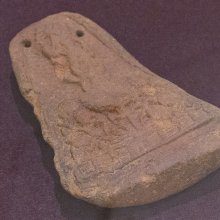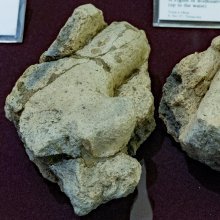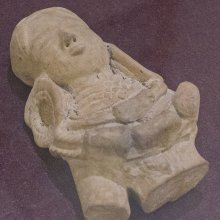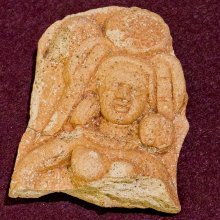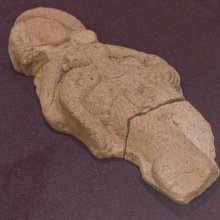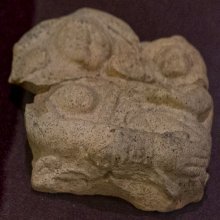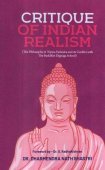Murti, Mūrti, Mūrtī, Mūrtti, Murtti: 28 definitions
Introduction:
Murti means something in Buddhism, Pali, Hinduism, Sanskrit, Jainism, Prakrit, the history of ancient India, Marathi, Hindi, Tamil. If you want to know the exact meaning, history, etymology or English translation of this term then check out the descriptions on this page. Add your comment or reference to a book if you want to contribute to this summary article.
Images (photo gallery)
(+29 more images available)
In Hinduism
Pancaratra (worship of Nārāyaṇa)
Source: SriMatham: Vaiṣṇava Iconology based on Pañcarātra Āgamamūrti–Anything which has definite shape and physical limits, an embodiment orincarnation. This is a Sanskrit term used in hindu iconology (e.g. the Āgamas).

Pancaratra (पाञ्चरात्र, pāñcarātra) represents a tradition of Hinduism where Narayana is revered and worshipped. Closeley related to Vaishnavism, the Pancaratra literature includes various Agamas and tantras incorporating many Vaishnava philosophies.
Shilpashastra (iconography)
Source: Red Zambala: Hindu Icons and Symbols | IntroductionMūrti (मूर्ति).—anything which has definite shape and physical limits, an embodiment or incarnation.
Source: Shodhganga: Elements of Art and Architecture in the Trtiyakhanda of the Visnudharmottarapurana (shilpa)Mūrti (मूर्ति) refers to one of the synonyms for “image” or “idol”, according to the Viṣṇudharmottarapurāṇa, an ancient Sanskrit text which (being encyclopedic in nature) deals with a variety of cultural topics such as arts, architecture, music, grammar and astronomy.—The Śilpaśāstras viz., the Bṛhatsaṃhitā, Mānasāra, Śilparatna, Devatāmurtiprakaraṇa etc. have the discussion on Iconography. Thus it can be assumed that in later period the practice of image worship came forward and still the practice of image worship is prevailing in Indian society. In Sanskrit, different words like mūrti, pratimā, devatārūpa etc. are used to denote image or idol.

Shilpashastra (शिल्पशास्त्र, śilpaśāstra) represents the ancient Indian science (shastra) of creative arts (shilpa) such as sculpture, iconography and painting. Closely related to Vastushastra (architecture), they often share the same literature.
Purana and Itihasa (epic history)
Source: archive.org: Puranic EncyclopediaMūrti (मूर्ति).—One of the thirteen daughters of Dakṣaprajāpati. This girl was married to Dharma. Nara and Nārāyaṇa are the sons born to Mūrti of Dharma. (4th Skandha, Bhāgavata).
Source: Cologne Digital Sanskrit Dictionaries: The Purana Index1a) Mūrti (मूर्ति).—A sage of the epoch of the Tenth Manu.*
- * Bhāgavata-purāṇa VIII. 13. 22.
1b) A son of Vasiṣṭha and a Prajāpati of the Svārociṣa epoch.*
- * Matsya-purāṇa 9. 9.
2) Mūrtī (मूर्ती).—A daughter of Dakṣa, and a wife of Dharma; mother of Nara and Nārāyaṇa.*
- * Bhāgavata-purāṇa IX. 4. 6; II. 7. 6; IV. 1. 50 and 52.

The Purana (पुराण, purāṇas) refers to Sanskrit literature preserving ancient India’s vast cultural history, including historical legends, religious ceremonies, various arts and sciences. The eighteen mahapuranas total over 400,000 shlokas (metrical couplets) and date to at least several centuries BCE.
Ganapatya (worship of Ganesha)
Source: Google Books: Ganapati: Song of the SelfMūrti (मूर्ति) refers to “physical objects consecrated for worship” (associated with the worship of a deity).—Mūrti (or pratima or arca) refers to “image” or “picture” and are physical objects consecrated for worship. They may be movable (cala) or immovable (acala). The latter are fixed on pedestals and cannot be moved once they are installed, and thus there is neither invocation nor dismissal for them. [...] For any external worship of Gaṇeśa, the first requirement that is absolutely necessary is a mūrti, an image (or photo) of Gaṇeśa. Not only should this image be a source of happiness, it should also invoke feelings of serenity within one. Second, his trunk should turn toward his left side, and his eyes should be looking directly at you.
Source: archive.org: Shiva Purana - (Ganesha)Mūrti (मूर्ति) refers to the “image (of Gaṇeśa)”, according to the Śivapurāṇa 2.4.18 (“Gaṇeśa crowned as the chief of Gaṇas”).—Accordingly, as Śiva said to Gaṇeśa: “[...] Then the rites shall formally be dismissed. Then he shall remember Gaṇeśa. Thus the Vrata shall be concluded auspiciously. When thus the Vrata is duly completed in a year, the devotee shall perform the rite of formal dismissal for the completion of the Vrata. At my bidding twelve brahmins shall be fed. After placing a jar your image (mūrti) shall be worshipped [pūjyā mūrtistvadīyikā]. [...]”.
Ganapatya (गाणपत्य, gāṇapatya) represents a tradition of Hinduism where Ganesha is revered and worshipped as the prime deity (ishta-devata). Being a minor though influential movement, Ganapatya evovled, llike Shaktism and Shaivism, as a separate movement leaving behind a large body of literature.
Vaishnavism (Vaishava dharma)
Source: Pure Bhakti: Brhad BhagavatamrtamMūrti (मूर्ति) refers to:—A form; Deity. (cf. Glossary page from Śrī Bṛhad-bhāgavatāmṛta).

Vaishnava (वैष्णव, vaiṣṇava) or vaishnavism (vaiṣṇavism) represents a tradition of Hinduism worshipping Vishnu as the supreme Lord. Similar to the Shaktism and Shaivism traditions, Vaishnavism also developed as an individual movement, famous for its exposition of the dashavatara (‘ten avatars of Vishnu’).
Shaktism (Shakta philosophy)
Source: Google Books: Manthanabhairavatantram1) Mūrti (मूर्ति) refers to “iconic” (e.g., mūrtirūpā—one who abides in an iconic form), according to the Śrīmatottara-tantra, an expansion of the Kubjikāmatatantra: the earliest popular and most authoritative Tantra of the Kubjikā cult.—Referring to the inner space within the triangular Yoni, the Śrīmatottara says: “O fair lady, thus Śrīnātha sports in the Circle of the Void (śūnyamaṇḍala) and (so does) Kubjikā, the mother of Kula who is Kuṇḍalī by name. [...] Applied on the plane of mantra and visualization, she who is undifferentiated (niṣkalā) is differentiated (sakalā). When she abides in the differentiated (aspect), she abides as mantra. Undifferentiated, she is devoid of mantra. When she abides in an iconic form [i.e., mūrti-rūpā], she is gross; she is subtle when present in the aniconic (amūrti) (aspect). Linked to the planes of mantra and iconic she is action impelled on the plane of visualization (dhyāna)”.
2) Mūrti (मूर्ति) refers to the “divine effigy”, according to Abhinava’s Tantrāloka verse 6.2-4.—Accordingly, “The places are said to be of three kinds: in the vital breath, in the body and outside (the body). The breath is five-fold in the body. (Thus, place) is of two kinds, according to whether it is outside (the body) or within (it). The external (places) are the maṇḍala, the sacrificial ground (sthaṇḍila), the (sacrificial) vessel (pātra), the rosary (akṣasūtra), the book (pustaka), the Liṅga, the skull (tūra), the cloth (paṭa), the image (made of papier-mâché) (pusta), the idol (pratimā), and the divine effigy (mūrti). Thus the outer (place) is of eleven kinds (each which are of) countless varieties. ”.

Shakta (शाक्त, śākta) or Shaktism (śāktism) represents a tradition of Hinduism where the Goddess (Devi) is revered and worshipped. Shakta literature includes a range of scriptures, including various Agamas and Tantras, although its roots may be traced back to the Vedas.
Shaivism (Shaiva philosophy)
Source: Brill: Śaivism and the Tantric TraditionsMūrti (मूर्ति) refers to the “embodiment (of the Pāśupata teaching)”, according to the Halāyudhastotra verse 3.—Accordingly, “Victorious is the One God, Śiva, the embodiment (mūrti) of the Kevalajñāna [i.e., kevalajñānamūrtir]”.

Shaiva (शैव, śaiva) or Shaivism (śaivism) represents a tradition of Hinduism worshiping Shiva as the supreme being. Closely related to Shaktism, Shaiva literature includes a range of scriptures, including Tantras, while the root of this tradition may be traced back to the ancient Vedas.
General definition (in Hinduism)
Source: Google Books: Understanding MantrasDeities have three forms (mūrti):
- as personifications (devatāmūrti);
- as symbolic diagrams (yantramūrti);
- and as sound (mantramūrti).
In Buddhism
Tibetan Buddhism (Vajrayana or tantric Buddhism)
Source: Brill: Śaivism and the Tantric Traditions (tantric Buddhism)Mūrti (मूर्ति) refers to the “body”, according to Kuladatta’s Kriyāsaṃgrahapañjikā, a text within Tantric Buddhism representing a construction manual for monasteries.—Accordingly, [vanayātrā in chapter 5]—“When the wood [to be used for the construction of a monastery] or the stones [to be used for the construction of a caitya] are brought into the city, [the Ācārya] should send a message [that these materials are being brought into the city] to the king or the citizens. He should make people with joyful minds whose bodies quiver with excitement (madana-sphūrti-mūrti) carry [these materials]”.

Tibetan Buddhism includes schools such as Nyingma, Kadampa, Kagyu and Gelug. Their primary canon of literature is divided in two broad categories: The Kangyur, which consists of Buddha’s words, and the Tengyur, which includes commentaries from various sources. Esotericism and tantra techniques (vajrayāna) are collected indepently.
In Jainism
General definition (in Jainism)
Source: The University of Sydney: A study of the Twelve ReflectionsMūrti (मूर्ति) refers to “form” (of an object), according to the 11th century Jñānārṇava, a treatise on Jain Yoga in roughly 2200 Sanskrit verses composed by Śubhacandra.—Accordingly, “Those objects having a pleasant form (puṇya-mūrti), which are seen in the morning and not at midday, vanish for the embodied souls in this world”.

Jainism is an Indian religion of Dharma whose doctrine revolves around harmlessness (ahimsa) towards every living being. The two major branches (Digambara and Svetambara) of Jainism stimulate self-control (or, shramana, ‘self-reliance’) and spiritual development through a path of peace for the soul to progess to the ultimate goal.
India history and geography
Source: Cologne Digital Sanskrit Dictionaries: Indian Epigraphical GlossaryMūrti.—(IE 7-1-2), ‘three’; rarely used to indicate ‘eight’; but cf. rūpa used in the sense of ‘one’. Note: mūrti is defined in the “Indian epigraphical glossary” as it can be found on ancient inscriptions commonly written in Sanskrit, Prakrit or Dravidian languages.

The history of India traces the identification of countries, villages, towns and other regions of India, as well as mythology, zoology, royal dynasties, rulers, tribes, local festivities and traditions and regional languages. Ancient India enjoyed religious freedom and encourages the path of Dharma, a concept common to Buddhism, Hinduism, and Jainism.
Languages of India and abroad
Marathi-English dictionary
Source: DDSA: The Molesworth Marathi and English DictionaryMūrtti (मूर्त्ति).—f (S) A statue, an idol, an image, any figure or definite shape. 2 The body. 3 (Freely.) A person, a man, an individual. Ex. āmhī cāra mūrtti āhōnta.
Source: DDSA: The Aryabhusan school dictionary, Marathi-Englishmūrti (मूर्ति).—f A statue, an idol. The body. A person.
Marathi is an Indo-European language having over 70 million native speakers people in (predominantly) Maharashtra India. Marathi, like many other Indo-Aryan languages, evolved from early forms of Prakrit, which itself is a subset of Sanskrit, one of the most ancient languages of the world.
Sanskrit dictionary
Source: DDSA: The practical Sanskrit-English dictionaryMūrti (मूर्ति).—f. [mūrcch-ktin]
1) Anything which has definite shape and limits, material element, matter, substance; एतत् सर्वं यन्मूर्तं चामूर्तं च तस्मान्मूर्तिरेव रयिः (etat sarvaṃ yanmūrtaṃ cāmūrtaṃ ca tasmānmūrtireva rayiḥ) Praśna Up.1.5.
2) A form, visible shape, body, figure; कौटिल्यधीरज्जु- निबद्धमूर्तिं मन्ये स्थिरां मौर्यनृपस्य लक्ष्मीम् (kauṭilyadhīrajju- nibaddhamūrtiṃ manye sthirāṃ mauryanṛpasya lakṣmīm) Mu.2.2; R.3.27; 14.54.
3) An embodiment, incarnation, personification, manifestation; करुणस्य मूर्तिः (karuṇasya mūrtiḥ) Uttararāmacarita 3.4; Pañcatantra (Bombay) 2.159.
4) An image, idol, a statue.
5) Beauty.
6) Solidity, hardness.
7) Body (kalevara); विशिखसंहतितापितमूर्तिभिः (viśikhasaṃhatitāpitamūrtibhiḥ) Kirātārjunīya 14.64; Manusmṛti 1.17,19.
8) A limb of the body (śarīrāvayava); नहि मे तप्यमानस्य क्षयं यास्यन्ति मूर्तयः (nahi me tapyamānasya kṣayaṃ yāsyanti mūrtayaḥ) Rām.1. 64.2.
9) (In phil.) The mind and the four elements earth, air, fire and water.
Derivable forms: mūrtiḥ (मूर्तिः).
Source: Cologne Digital Sanskrit Dictionaries: Shabda-Sagara Sanskrit-English DictionaryMūrtti (मूर्त्ति).—f.
(-rttiḥ) 1. Matter, substance, solidity. 2. The body. 3. Figure, form, body in general, or any definite shape or image. 4. Manifestation. 5. Beauty. 6. Hardness. E. mūrcch to faint, to become insensible, aff. ktin, form irr.
Source: Cologne Digital Sanskrit Dictionaries: Benfey Sanskrit-English DictionaryMūrti (मूर्ति).—probably better mūrtti, i. e. mṛd + ti, cf. [Mānavadharmaśāstra] 12, 120. 1. Matter, substance, [Mānavadharmaśāstra] 1, 17; hard substances, [Mānavadharmaśāstra] 12, 120 (Jones: the terrene parts of the human body). 2. Figure, form, [Bhartṛhari, (ed. Bohlen.)] 2, 1; [Pañcatantra] ii. [distich] 169. 3. Body, [Rājataraṅgiṇī] 5, 364. 4. Incarnation, [Mānavadharmaśāstra] 1, 98. 5. Image, [Mānavadharmaśāstra] 2, 225. 6. Beauty, [Pañcatantra] ii. [distich] 107.
Source: Cologne Digital Sanskrit Dictionaries: Cappeller Sanskrit-English DictionaryMūrti (मूर्ति).—[feminine] (firm) body, embodiment, form, shape, image, person, adj. —° formed of; [plural] the solid parts of the body.
Source: Cologne Digital Sanskrit Dictionaries: Monier-Williams Sanskrit-English Dictionary1) Mūrti (मूर्ति):—[from mūrch] f. any solid body or material form, ([plural] material elements, solid particles; ifc. = consisting or formed of), [Upaniṣad; Manu-smṛti; Mahābhārata] etc.
2) [v.s. ...] embodiment, manifestation, incarnation, personification, [Taittirīya-brāhmaṇa; Manu-smṛti; Mahābhārata] etc. ([especially] of Śiva, [Hemādri’s Caturvarga-cintāmaṇi])
3) [v.s. ...] anything which has definite shape or limits (in [philosophy] as mind and the 4 elements earth, air, fire, water, but not ākāśa, ether, [Indian Wisdom, by Sir M. Monier-Williams 52 n. 1]), a person, form, figure, appearance, [Mahābhārata; Kāvya literature] etc.
4) [v.s. ...] an image, idol, statue, [Kāvya literature]
5) [v.s. ...] beauty, [Pañcatantra]
6) [v.s. ...] Name of the first astrological house, [Varāha-mihira’s Bṛhat-saṃhitā]
7) [v.s. ...] of a daughter of Dakṣa and wife of Dharma, [Bhāgavata-purāṇa]
8) [v.s. ...] m. Name of a Ṛṣi under the 10th Manu, [ib.]
9) [v.s. ...] of a son of Vasiṣṭha, [Viṣṇu-purāṇa]
Source: Cologne Digital Sanskrit Dictionaries: Yates Sanskrit-English DictionaryMūrtti (मूर्त्ति):—(ttiḥ) 2. f. Matter; form, figure; the body; an image.
Source: DDSA: Paia-sadda-mahannavo; a comprehensive Prakrit Hindi dictionary (S)Mūrtti (मूर्त्ति) in the Sanskrit language is related to the Prakrit word: Mutti.
[Sanskrit to German]
Sanskrit, also spelled संस्कृतम् (saṃskṛtam), is an ancient language of India commonly seen as the grandmother of the Indo-European language family (even English!). Closely allied with Prakrit and Pali, Sanskrit is more exhaustive in both grammar and terms and has the most extensive collection of literature in the world, greatly surpassing its sister-languages Greek and Latin.
Hindi dictionary
Source: DDSA: A practical Hindi-English dictionaryMūrti (मूर्ति):—(nf) an idol, statue; image; -[kalā] sculpture; statuary; ~[kāra] sculptor; statuary; ~[pūjaka] an idolater; -[pūjana/pūjā] idolatry; ~[bhaṃjaka] an iconoclast; -[bhaṃjana] iconoclasm; ~[vijñāna] iconography; -[saṃgraha] statuary; —, [laghu] statuette; —[toḍanā] to indulge in iconoclasm; to shatter a statue/an image.
...
Kannada-English dictionary
Source: Alar: Kannada-English corpusMūrti (ಮೂರ್ತಿ):—
1) [noun] the shape, outline or configuration of anything; the form; any solid body; a material form.
2) [noun] the physical structure of a human being; the body.
3) [noun] an idol of a deity, human being etc.; a statue.
4) [noun] an assuming of a physical form (as by an abstract principle); manifestation; embodiment; personification.
5) [noun] the quality of being hard, rigid or solid.
6) [noun] the quality of being beautiful; beauty.
7) [noun] a crow.
8) [noun] (math.) a symbol for the number three.
Kannada is a Dravidian language (as opposed to the Indo-European language family) mainly spoken in the southwestern region of India.
Tamil dictionary
Source: DDSA: University of Madras: Tamil LexiconMūrtti (மூர்த்தி) noun < mūrti.
1. Body; embodiment; உடல். ஒத்தொளிரு மூர்த்தியார் [udal. otholiru murthiyar] (சூளாமணி குமார. [sulamani kumara.] 1).
2. Form; figure; வடிவம். அன்பெனு மூர்த்தியார் [vadivam. anpenu murthiyar] (பெரியபுராணம் மூர்த்தி. [periyapuranam murthi.] 9).
3. God; கடவுள். திரிமூர்த்தி. [kadavul. thirimurthi.]
4. Arhat; அருகன். (திவா.) [arugan. (thiva.)]
5. The Buddha; புத்தன். (திவா.) [puthan. (thiva.)]
6. Śiva; சிவன். (யாழ்ப்பாணத்து மானிப்பாயகராதி) [sivan. (yazhppanathu manippayagarathi)]
7. The Śakti of cattiyōcātam; சத்தியோ சாதத்தின் சத்தி. (சதாசிவ.) [sathiyo sathathin sathi. (sathasiva.)]
8. Ascetic; one who performs penance; தவமேடமுடையவன். [thavamedamudaiyavan.] (சீவகசிந்தாமணி [sivagasindamani] 3071.)
9. Saint, sage, great personage, a term of reverence; பெரிய.ார். ஓதுவார்மூர்த்தி. [periyar. othuvarmurthi.]
10. Lord; தலைவன். (யாழ்ப்பாணத்து மானிப்பாயகராதி) [thalaivan. (yazhppanathu manippayagarathi)]
11. Matter; substance; பொருள். (யாழ்ப்பாணத்து மானிப்பாயகராதி) [porul. (yazhppanathu manippayagarathi)]
12. Style; fashion; மாதிரி. (யாழ்ப்பாணத்து மானிப்பாயகராதி) [mathiri. (yazhppanathu manippayagarathi)]
Tamil is an ancient language of India from the Dravidian family spoken by roughly 250 million people mainly in southern India and Sri Lanka.
See also (Relevant definitions)
Starts with (+38): Murtibala, Murtibhamjaka, Murtibhamjakate, Murtibhamjaki, Murtibhamjane, Murtibhava, Murtibhavisu, Murtibheda, Murtidhara, Murtidharin, Murtidharini, Murtidhyana, Murtigol, Murtigollu, Murtika, Murtikrama, Murtilakshana, Murtilinga, Murtimamta, Murtimana.
Ends with (+248): Abhicarikamurti, Abhicharikamurti, Abhimanamurti, Acyutamurti, Adimurti, Adivyamurti, Aghorabhairavamurti, Aghoramurti, Akaradikshakarantavarnamurti, Alinganamurti, Alpamurti, Amritamurti, Amurti, Anadimurti, Anandamurti, Anekamurti, Animishashrayamurti, Anugrahamurti, Anupamamurti, Apomurti.
Full-text (+543): Mutti, Dakshinamurti, Jalamurtti, Somaskandamurti, Khamurtti, Tapomurtti, Alpamurtti, Khalamurtti, Namramurtti, Murtitas, Jalamurttika, Bahumurtti, Tantavamurtti, Umasahitamurti, Murtisamcara, Umamaheshvaramurti, Ardhanarishvaramurti, Acyutamurti, Atanamurtti, Nrittamurti.
Relevant text
Search found 93 books and stories containing Murti, Moorthi, Murthi, Mūrti, Mūrtī, Mūrtti, Murtti; (plurals include: Murtis, Moorthis, Murthis, Mūrtis, Mūrtīs, Mūrttis, Murttis). You can also click to the full overview containing English textual excerpts. Below are direct links for the most relevant articles:
Brihad Bhagavatamrita (commentary) (by Śrī Śrīmad Bhaktivedānta Nārāyana Gosvāmī Mahārāja)
Verse 2.2.49 < [Chapter 2 - Jñāna (knowledge)]
Verse 2.3.25 < [Chapter 3 - Bhajana (loving service)]
Verse 2.3.66 < [Chapter 3 - Bhajana (loving service)]
The Shiva Purana (by J. L. Shastri)
Chapter 3 - Upamanyu’s advice to lord Kṛṣṇa < [Section 7.2 - Vāyavīya-saṃhitā (2)]
Chapter 31 - The Hymn of lord Śiva < [Section 7.2 - Vāyavīya-saṃhitā (2)]
Chapter 38 - Obstacles in the path of Yoga < [Section 7.2 - Vāyavīya-saṃhitā (2)]
Sahitya-kaumudi by Baladeva Vidyabhushana (by Gaurapada Dāsa)
Text 11.18 < [Chapter 11 - Additional Ornaments]
Text 4.65 < [Chapter 4 - First-rate Poetry]
Text 1.14 < [Chapter 1 - The Purpose of Poetry]
The Religion and Philosophy of Tevaram (Thevaram) (by M. A. Dorai Rangaswamy)
Introduction to second volume < [Volume 2 - Nampi Arurar and Mythology]
Chapter 2.3 - Partha-anugraha-murti (depiction of the story of Arjuna) < [Volume 2 - Nampi Arurar and Mythology]
Nayanar 1: Sundarar (Nampi Arurar) < [Volume 4.1.1 - A comparative study of the Shaivite saints the Thiruthondathogai]
Cidgaganacandrika (study) (by S. Mahalakshmi)
Verse 69 [Agni Mūrti] < [Chapter 2 - Second Vimarśa]
Verse 300 [Śambhava-Śākta-Guru kramas] < [Chapter 4 - Fourth Vimarśa]
Verse 70 [Pralayāgni] < [Chapter 2 - Second Vimarśa]
Shaiva Upanishads (A Critical Study) (by Arpita Chakraborty)
18. Sadāśiva Cakra < [Chapter 5 - Essence of Pañcabrahma Upaniṣad]
13. Forms are for Visualization < [Chapter 5 - Essence of Pañcabrahma Upaniṣad]
16. Aghorāstra-mūrti < [Chapter 5 - Essence of Pañcabrahma Upaniṣad]
Related products
